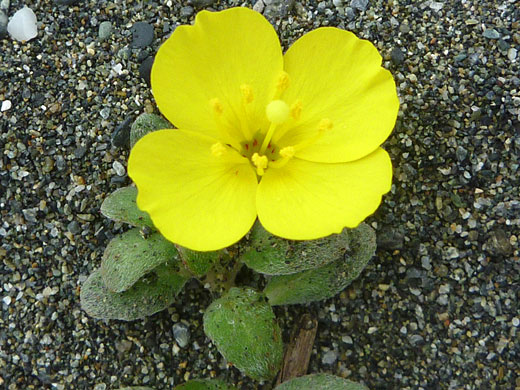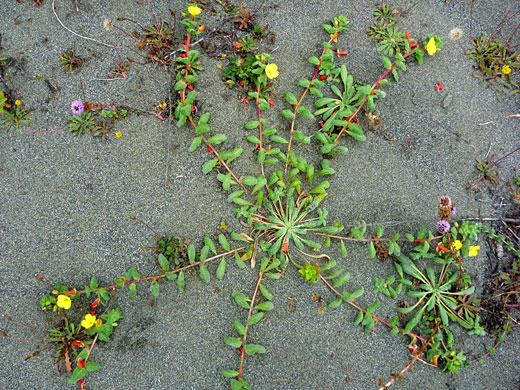Camissoniopsis Cheiranthifolia, Beach Spotted Suncup
Plants > Wildflowers > Onagraceae > Camissoniopsis Cheiranthifolia
Common names:
Beach spotted suncup, beach evening primrose
Family:
Scientific name:
Camissoniopsis cheiranthifolia
Synonym:
Camissonia cheiranthifolia
Main flower color:
Range:
Coastal areas of California and Oregon
Height:
Up to 4 feet; usually prostrate
Habitat:
Beach margins, sand dunes; below 300 feet
Leaves:
Narrow; ovate to obovate, up to 2 inches long
Season:
April to August
Camissoniopsis cheiranthifolia grows only beside the Pacific coast, from the Channel Islands northwards into Oregon, inhabiting sandy areas, sometimes only just above the high water line. Stems can point upwards but generally run along the ground, branching from the base. Leaves form a neat basal rosette and also grow all the way along the stems, at alternate intervals. Leaves usually have a dense covering of strigose hairs, pressed against the surface, and their edges may be lined by very fine teeth. Basal leaves are attached by short stalks.
Flowers are borne at the end of the stems; they have four green sepals and four broad yellow petals, about twice as long (up to 0.8 inches), usually with two (or one) red spots at the base. At the center are a spherical stigma and eight stamens, half of which (those opposite the sepals) are longer than the others. Anthers are attached to the stamens in the middle.
Ssp cheiranthifolia is a smaller-flowered variety (petals less than half an inch long), with the stigma and anthers held at similar heights, while ssp suffruticosa has petals over half an inch long, the stigma somewhat above the anthers, and hairs which are dense and silvery.
Flowers are borne at the end of the stems; they have four green sepals and four broad yellow petals, about twice as long (up to 0.8 inches), usually with two (or one) red spots at the base. At the center are a spherical stigma and eight stamens, half of which (those opposite the sepals) are longer than the others. Anthers are attached to the stamens in the middle.
Ssp cheiranthifolia is a smaller-flowered variety (petals less than half an inch long), with the stigma and anthers held at similar heights, while ssp suffruticosa has petals over half an inch long, the stigma somewhat above the anthers, and hairs which are dense and silvery.
All Contents © Copyright The American Southwest | Comments and Questions | Contribute | Site Map




